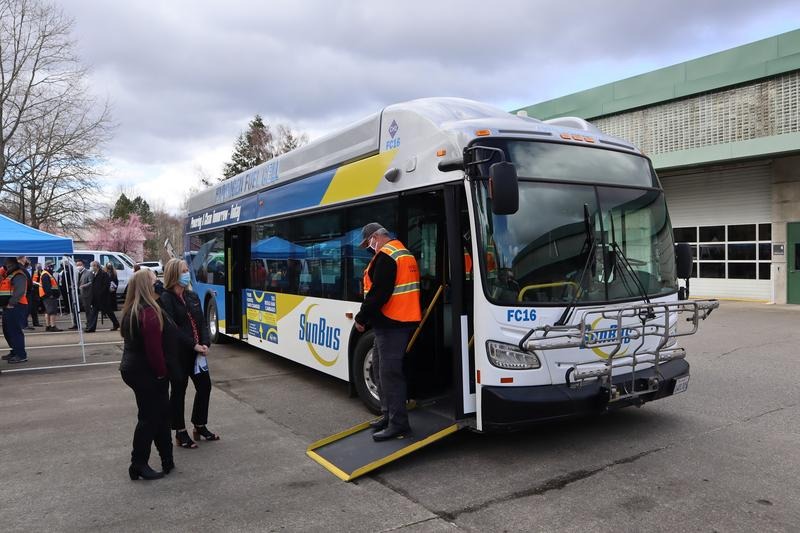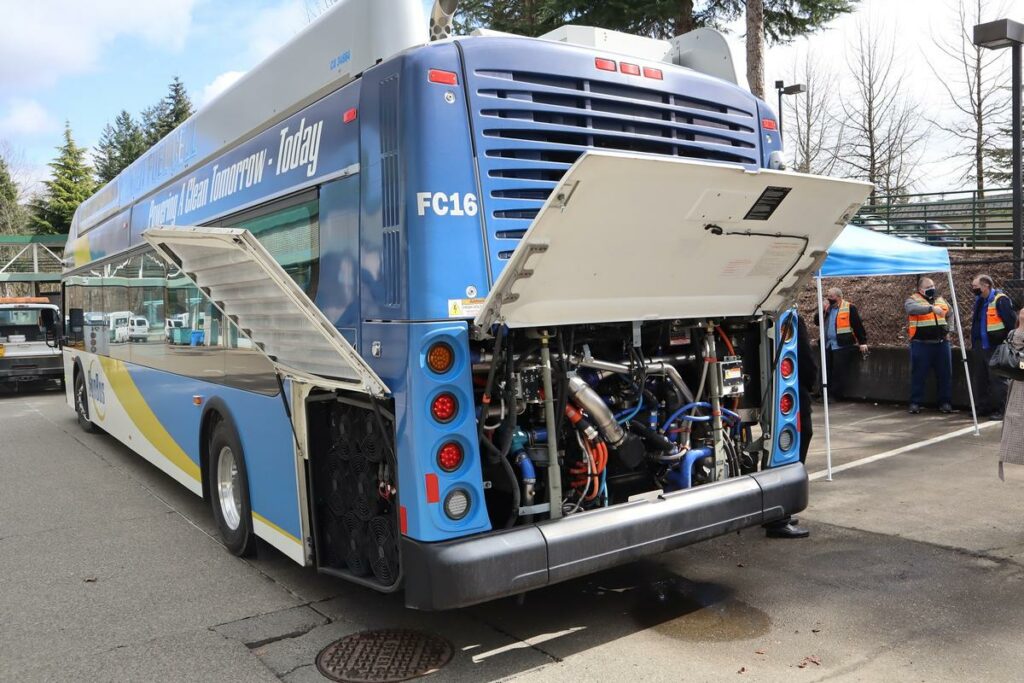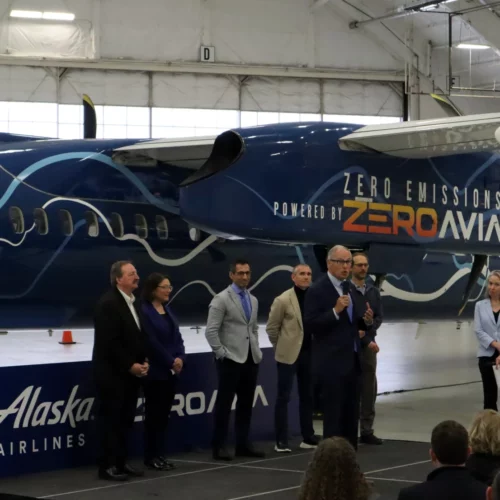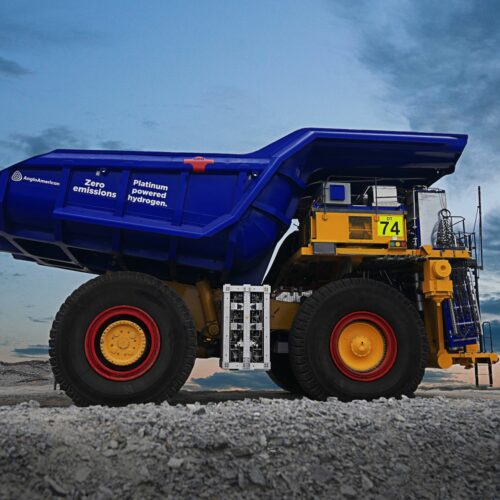
Interest In Hydrogen Fuel Grows Across The Northwest – And Tax Dollars Follow
READ ON
More folks from Northwest government and industry are jumping on the hydrogen bandwagon to test if the alternative fuel could be a viable and green replacement for diesel and gasoline in some situations. The potential converts include more than half a dozen transit agencies from Everett to Eugene, state legislators and Boeing’s drone subsidiary in the Columbia River Gorge.
A week-long demonstration tour with a hydrogen fuel cell electric bus drew interest from transit managers and drivers. It started at Kitsap Transit last Wednesday and is continuing down the Interstate 5 corridor with eight more stops at agencies large and small including Sound Transit, Pierce Transit, TriMet and Lane Transit District.
“We’re studying all of these opportunities to try to determine what is the best path for our community here to a cleaner environment,” Ann Freeman-Manzanares, general manager of Intercity Transit, said when the demonstration hydrogen bus stopped in Olympia Thursday.
A hydrogen fuel cell doesn’t burn anything. It uses a chemical reaction between the hydrogen fuel and oxygen from the air to produce electricity to drive a motor. Fuel cell vehicle tailpipes emit only water vapor and warm air.
However, hydrogen fueling is comparatively more expensive than battery electric and diesel bus technology. The advantage is that a hydrogen fuel cell bus can operate much like current diesel buses can, but with zero emissions and without the range limitation and recharging downtime that current battery-powered buses have.
“I am really intrigued — still have lots to learn — but really intrigued by the idea of creating hydrogen on site by solar so it is a clean fuel source,” Freeman-Manzanares said in an interview.
TriMet in Portland has committed to phasing in an all-alternative fuel bus fleet by 2040. So far, its evaluation of options is leaning toward battery electric propulsion. But hydrogen remains on the table for some routes.
“While this technology is not TriMet’s preferred approach at this time, the agency is looking into its long-term potential,” said spokesperson Tia York in an email. “Part of the process includes seeking grant funding for acquisition of test vehicles and associated fueling equipment.”
At Twin Transit in Chehalis, General Manager Joe Clark is awaiting delivery of two electric buses, which he hopes to compare in real world use to two hydrogen fuel cell buses and to conventional buses. Clark said Twin Transit has applied for federal funding to buy the hydrogen-powered models.
First hydrogen fueling station in Northwest coming to Chehalis
Clark said the stars were aligning to move in an eco-friendly direction because his home town is also set to host the Northwest’s first commercial hydrogen fueling station. The Washington House of Representatives has tentatively included $2.5 million to pay for it in the new state construction spending budget.

Bus manufacturer New Flyer and fuel cell maker Ballard Power Systems of Vancouver, Canada, showed off the compressed hydrogen-powered bus to Washington and Oregon transit agencies. CREDIT: Tom Banse/N3
That inaugural compressed hydrogen fill-up location, which may open in early 2022, could be joined by a second one along I-5 closer to Portland because the Bonneville Environmental Foundation last fall received private grant funding to build a demonstration station in southwest Washington.
The region’s third hydrogen fueling station could be built in East Wenatchee after the state senator from that area recently added $1.5 million to the Washington Senate transportation budget to pay for it.
The state House and Senate still need to agree on finalized spending blueprints, but the current outlook excited one of the leading advocates for renewable hydrogen in Olympia.
“I’m starting to picture the corridors,” said lobbyist Dave Warren, a consultant to the Douglas County Public Utility District. “It’s heartening to see the progress with the sector growing so fast.”
The fueling stations would receive their hydrogen supply from Douglas PUD, which broke ground earlier this month on a green hydrogen production facility near Wenatchee. The main feature of the plant will be an electrolyzer, which uses unsold electricity from the PUD’s dam on the Columbia River to split water molecules into oxygen and hydrogen.
Hydrogen fueling still has plenty of skeptics. In an opinion column in The Guardian newspaper this month, British environmentalist Jonathan Porritt cautioned not to believe the “hydrogen hype.”
“The gulf between [the] current reality, one rarely mentioned by hydrogen enthusiasts, and the prospect of readily available and affordable green hydrogen that could help us get to net zero, is absolutely vast,” Porritt wrote.
Porritt said electric batteries make more sense to power vehicles, while adding that hydrogen may still have a good case for use in “hard-to-abate” sectors such as maritime shipping and steel and cement making.
Meanwhile, up in the air
Boeing’s Columbia River Gorge-based subsidiary Insitu this month provided details about its testing of a hydrogen-powered variant of its popular ScanEagle reconnaissance drone.
Insitu said it was drawing interest from the defense sector because the fuel cell motor would be stealthier by virtue of being quieter and having a smaller heat signature than with current gasoline-powered engines.
A fuel cell-powered unmanned aircraft could represent “a significant game changer in the battlespace,” said Insitu Pacific Managing Director Andrew Duggan in a media release.
“Operationally, fuel cell-powered platforms provide the potential for longer endurance missions, increased power availability for payloads, as well as significant reductions in noise signature,” Duggan said.
An engineering department lab at Washington State University assisted Insitu with the development of the next generation liquid hydrogen fueling technology.
Related Stories:

Retired Alaska Airlines turboprop to get new life as ‘world’s largest’ hydrogen-powered plane
Alaska Airlines ceremonially handed over a surplus turboprop airliner on Monday to a company that aims to turn it into the largest hydrogen-powered plane yet to fly.

Hydrogen-powered airliner makes first flight at Moses Lake, offering preview of possible future
The largest aircraft yet to fly on hydrogen-electric power made a successful first flight in Moses Lake, Washington, on Thursday. The maiden flight of a converted turboprop airliner offered a preview of one possible pathway for how to make your future flights more eco-friendly. Hydrogen fuel is one of several options the aviation industry is testing to reduce its carbon footprint, but the technology still attracts notable skepticism.

Battery-powered mining trucks to see test run in Lewis County
The site of the last coal-fired power plant in Washington state will soon be home to proving grounds for a carbon-emissions free mining truck.
The truck is a battery and hydrogen fuel cell powered vehicle, developed by Seattle-based First Mode, and it’s the largest emissions free vehicle in the world. Chris Voorhees, co-founder and chief product and technology officer at First Mode, said they’ve developed the technology to focus on decarbonizing the industry that provides the products that fuel our daily lives. Unlike other cleantech engineering focused on the consumer-end products like electric vehicles and solar panels, Voorhees said First Mode is looking at the opposite end of the supply chain.















